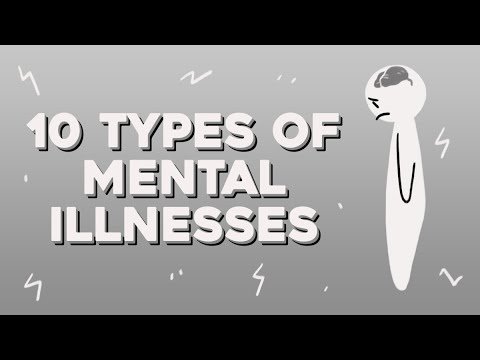(upbeat music) Before we begin we’d like to add a quick warning discretion. This video discusses #mentalillness including #eatingdisorders and #PTSD. What is #mentalillness? According to #NationalAllianceonMentalIllness, it’s defined as a condition that affects a person’s thinking, feeling or mood for a sustained period of time that negatively impacts them.
You might be wondering, is #depression a #mentalillness? What about #anxiety? Yes, they are. In fact, they’re the most common types of #mentalillnesses. In this video, Psych2go covers 10 of the most common types of #mentalillnesses.
One, #anxietydisorders. We know 18.1% doesn’t sound like a lot but that’s the number of #adults in the US who suffer from #anxietydisorders. 40 million people suffer from symptoms of an #anxietydisorder every year. Of those 40 million people, it’s estimated that only 36.9% of them will get help. #Anxietydisorders rarely appear alone, with #depression being a common co-diagnosis. #Anxietydisorders come in a few varieties, generalized #anxietydisorder, GAD, #panicdisorder, #socialanxietydisorder, #SAD and #obsessivecompulsivedisorder, #OCD.
So, what do all these #anxietydisorders have in common? They’re all characterized by
nearly uncontrollable worry that messes with several aspects of daily life such as sleep, relationships,
school and work. The good news is there are several treatment options available, which include different types of therapy and medication.
Two, #personalitydisorders. What does it mean when someone’s personality is disordered? #Personalitydisorders refer to #behavioral, emotional and thought patterns that deviate greatly from the expectations of an individualist culture. The #NationalInstituteofMentalHealth suggests that 9.1 of the population has the traits of a #personalitydisorder.
So what does this look like in real life? Could anyone who’s a little different be diagnosed with a #personalitydisorder? Well, according to the diagnostic criteria in the DSMV these differences must
be causing the individual significant amounts of distress in the way they see themselves, others and situations, inappropriate or exaggerated emotional responses, impulse control and how well
the individual relates to and functions around others. #Personalitydisorders can’t be cured but thankfully they can be treated. This treatment consists of combinations of medications for the underlying #mentalhealthissues as well as talk therapy.
Three, #attentiondeficithyperactivitydisorder. If we say #ADHD what comes to mind? The stereotype of a
person diagnosed with #ADHD is usually a small #child who’s bouncing off the walls or can’t finish a task.
However, between 7.8 and 11% of #children aged four to 17 are diagnosed with #ADHD any given year. #ADHD affects people of all ages and includes multiple symptoms such as inability to concentrate, forgetfulness, inability ability to sit still, restlessness and losing things. An individual’s symptoms
vary depending on their age, gender and type of #ADHD. Did you know there’s actually three recognized types of #ADHD? There #ADHD, combined type #ADHD, impulsive/hyperactive type in #ADHD, inattentive and destructible type.
Most people think meds are the only way to control #ADHD. Well many people diagnosed
with the disorder find relief by using a combination of medications, life coaching, education and talk therapy.
Four, #posttraumaticstressdisorder. Did you know that an estimated 6.8% of the US population will develop some form of #posttraumaticstressdisorder. That’s about 19 million people in the US alone. So how does this happen? You, me, everybody will get stressed out by something in our lives.
Some people will come across something so stressful that it affects them permanently. For many of them this stress becomes trauma. A traumatic event is considered any event that should not have happened,
such as a natural disaster an assault, childhood neglect, abuse, starvation and so on. Just as a completely
normal reaction to trauma what will happen when the threat is gone? The #stress and trauma stops
on its own for most people, when the mind and body understand the individual is no longer under attack. But what if the mind and body don’t get the memo? #Posttraumaticstressdisorder refers to a prolonged fight or flight response that happens after the stressful event has stopped. #Complexposttraumaticstressdisorder, #CPTSD refers to the #PTSD that
occurs due to a series of continued traumatic events, such as childhood abuse. Think of #PTSD and #CPTSD as the echoes of the #stress response.
These echoes can happen in the form of emotional flashbacks, nightmares, extreme anxiety or panic, difficulties connecting to others and an overwhelming sense of fear. So how does someone get help
for something so overwhelming? People suffering from #PTSD or #CPTSD can find relief through trauma therapies, which is eye movement desensitization reprocessing EMDR or traditional talk therapies such as #cognitivebehavioraltherapy, #CBT or #dialecticalbehaviortherapy, #DBT.
#James Donaldson notes:
Welcome to the “next chapter” of my life… being a voice and an advocate for #mentalhealthawarenessandsuicideprevention, especially pertaining to our younger generation of students and student-athletes.
Getting men to speak up and reach out for help and assistance is one of my passions. Us men need to not suffer in silence or drown our sorrows in alcohol, hang out at bars and strip joints, or get involved with drug use.
Having gone through a recent bout of #depression and #suicidalthoughts myself, I realize now, that I can make a huge difference in the lives of so many by sharing my story, and by sharing various resources I come across as I work in this space. #http://bit.ly/JamesMentalHealthArticle
Order your copy of James Donaldson’s latest book,
#CelebratingYourGiftofLife:
From The Verge of Suicide to a Life of Purpose and Joy
Five, #depression. An estimated 6.7% of the US population over the age of 18 15.7 million people live with #depression. Although the occasional low mood is a normal response to negative situations,
#depression entails low moods that are severe and last longer than six weeks. #Depression manifests
differently in #women than #men. #Women tend to experience #depression as feelings of sadness, worthlessness and shame or guilt.

#Men tend to mistake the symptoms of #depression as fatigue and being easily irritated. Common treatments for #depression include #cognitivebehavioraltherapy, #CBT, #interpersonaltherapy,
#IPT, psychodynamic therapy, psycho education groups, antidepressants and various brain stimulation therapies.
Six, #bipolardisorder. An estimated 2.8% of the US population that sought #mentalhealthtreatment was diagnosed with some form of #bipolardisorder in 2018. This number may be low, as many individuals who suffer from any #mentalhealthdisorder do not seek treatment. #Bipolardisorder means a lot more than just really bad mood swings for a couple of reasons. First people diagnosed with #bipolardisorder cannot completely control these mood swings and in second, these mood swings range from manic, feeling super happy or invincible, doing crazy spontaneous things, grandiosity and having racing or unrealistic thoughts to extreme bouts of #depression and maybe a little hypomania in between.
Living with #bipolardisorder isn’t easy but people struggling with the disorder can find a variety of medications and traditional counseling treatments to help them find more balance.
Seven, #eatingdisorders. Did you know there are almost as many people living with #eatingdisorders as there are with #bipolardisorder? It’s true. Approximately 2.7% of individuals who sought treatment were diagnosed with an #eatingdisorder in 2018. The most common question people ask about #eatingdisorders is what’s the difference between not being happy with your body and having
an #eatingdisorder? Well, in addition to this total focus on their physical flaws, #eatingdisorders are defined by #dysmorphia and the binge purge restrict cycle of #behavior. This cycle comes from the person’s feelings of extreme distress and disgust about their body. This disgust drives the individual who has the disorder to become super focused on their body weight and shape. Leave a comment below
if you wanna know more about the binge purge restrict cycle.
The #eatingdisorders everyone knows about are #anorexianervosa and #bulimia but most people have never heard of #eatingdisorders not otherwise specified, EDNOS or avoidant restrictive food intake disorder, ARFID. Leave a comment below if you wanna hear more about the lesser known #eatingdisorders. Everyone needs food, so how is someone who has such a terrible relationship with eating and body image supposed to get better? Recovery from an #eatingdisorder is totally possible. With a combination of talk therapy, residential treatment and medications to treat the symptoms of any underlying #mentalhealthconditions.
Eight, #obsessivecompulsivedisorder. If #obsessivecompulsivedisorder, #OCD is a type of #anxietydisorder, why does it make the number eight spot? Simple professionals day 2.3% of individuals will qualify for a diagnosis of #OCD during the course of their lifetime. What’s the first thing you
think of when you think of someone who suffers from #obsessivecompulsivedisorder? Did you imagine someone who can’t stand the thought of germs? Maybe a person who turns the doorknob 27 times before they can leave the house? The common stereotype of an individual diagnosed with #obsessivecompulsivedisorder, #OCD is if someone obsessed with cleaning or counting to a comical degree but that’s not the whole picture.
The reality of #OCD includes a great deal of #anxiety, rigid thinking and feeling isolated from others. Individuals diagnosed with #OCD suffer from reoccurring thoughts that they cannot control, which are referred to as obsessions. These obsessions can be things like cleaning or accounting but also include checking and double checking, feeling as though one will be punished for being a sinner. Organizing and arranging and hoarding. Having obsessions is different from being detail oriented or a little type A because individuals who suffer from obsessions experience crippling #anxiety due to these thoughts
they’re unable to control. The compulsions are the actions such as cleaning, hand washing, arranging and
hoarding, individuals use to cope with overwhelming #anxiety and rigid thinking. So what is someone who lives with the reality of #OCD to do? Although there’s no cure for #OCD, a combination of medical and talk therapy will help them manage their symptoms effectively.
Nine, #autismspectrumdisorder #ASD. We’ve been hearing more and more about #autismspectrumdisorder #ASD in recent years. That’s because approximately 1.2% of #children, one in 59 #children will qualify for a diagnosis of #autismspectrumdisorder in the coming year. #ASD begins in #childhood but many individuals are not diagnosed until #adolescence or #adulthood. #ASD is characterized by significantly impaired social interactions, learning and communication. Individuals with #ASD may seem eccentric or unemotional to others, as they do not understand normal social cues. Some of these #behaviors include seeming off in their own world, repetitive thoughts or #behaviors, restricted interests, poor eye contact and difficulty communicating with others to the point their functioning
is greatly impaired. The most common treatments for #ASD include special education classes, applied #behavioral analysis, ABA therapy, occupational therapy, speech therapy, #behavioral management, therapy and medication management.
And 10, #schizophrenia and psychotic disorders. Did you know three out of 100 people will experience the symptoms of psychosis in their lifetime? Yep, this means 1% of the population suffers from a #psychotidisorder. People usually have their first psychotic break between the ages of 16 and 30 which means approximately 100000 #adolescents and #adults will experience their first #psychotic break every year.
This does not mean everyone who experiences #psychosis will always have a #psychoticdisorder. Medical and environmental or situational factors such as extreme #stress, certain prescriptions and illicit drugs can
induce temporary #psychosis. For individuals with a #psychoticdisorder however, the symptoms last longer than six months. So, what is #psychosis anyway? Someone suffering from #psychosis has breaks or disruptions in their reality, which manifests in #behaviors such as religious delusions, audio visual or tactile hallucinations, feelings of #paranoia or persecution and disordered or jumbled thoughts and speech. #Schizophrenia is the most common #psychoticdisorder but the DSMV recognize a few others. Would you like to know more about the other #psychoticdisorders? Then tell us in the comments below.
Having a #psychoticdisorder can feel like torture but it doesn’t have to. Many people who are diagnosed
with some type of #psychosis are successfully treated with a combination of specialized medications,
therapy and case management. Have you or a loved one ever dealt with any of the #mentalillnesses in this article? Were there any symptoms on this list that surprised you? Which #mentalillnesses do
you wanna hear more about? Tell us in the comments below. As always, any information provided here is for educational purposes only. If you need #mentalhealthcounseling or treatment, please contact your insurance company, local college #students counseling clinic or your county crisis line, help is out there. For more information on #mentalillness and #mentalhealth, stay tuned to Psych2go. As always, thanks for watching..





